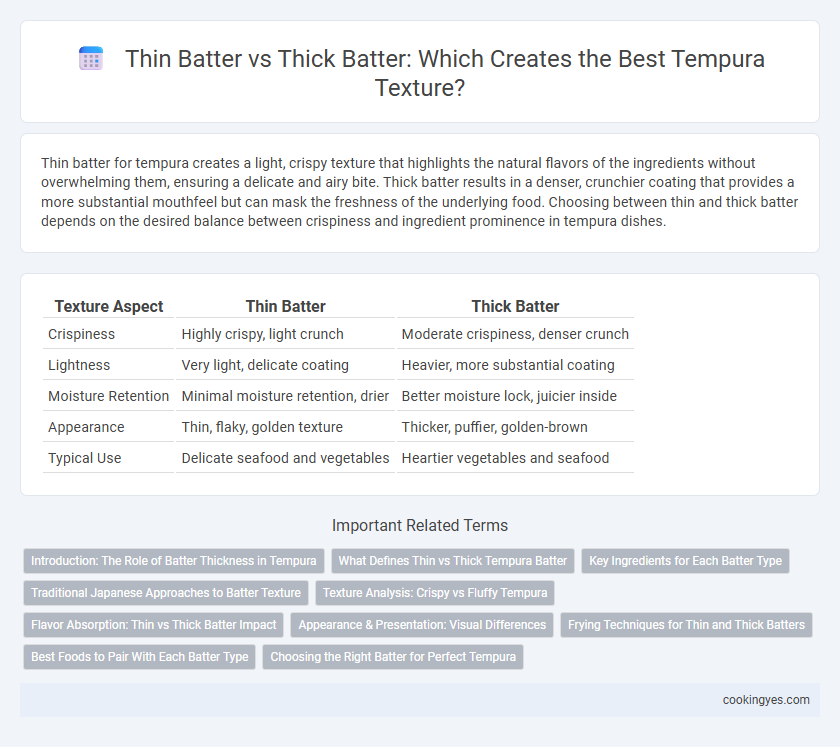Thin batter for tempura creates a light, crispy texture that highlights the natural flavors of the ingredients without overwhelming them, ensuring a delicate and airy bite. Thick batter results in a denser, crunchier coating that provides a more substantial mouthfeel but can mask the freshness of the underlying food. Choosing between thin and thick batter depends on the desired balance between crispiness and ingredient prominence in tempura dishes.
Table of Comparison
| Texture Aspect | Thin Batter | Thick Batter |
|---|---|---|
| Crispiness | Highly crispy, light crunch | Moderate crispiness, denser crunch |
| Lightness | Very light, delicate coating | Heavier, more substantial coating |
| Moisture Retention | Minimal moisture retention, drier | Better moisture lock, juicier inside |
| Appearance | Thin, flaky, golden texture | Thicker, puffier, golden-brown |
| Typical Use | Delicate seafood and vegetables | Heartier vegetables and seafood |
Introduction: The Role of Batter Thickness in Tempura
Thin batter creates a delicate, crispy texture that enhances the natural flavors of ingredients without overpowering them. Thick batter offers a more substantial, crunchy coating that provides a satisfying bite and retains moisture within the tempura. Choosing the right batter thickness influences the overall mouthfeel and authenticity of traditional Japanese tempura dishes.
What Defines Thin vs Thick Tempura Batter
Thin tempura batter consists of a simple mixture of ice-cold water and flour, sometimes with a small amount of egg, creating a light, crisp coating that emphasizes the natural flavors and textures of the ingredients. Thick tempura batter incorporates additional ingredients like cornstarch or baking powder, resulting in a denser, crunchier texture with a more substantial coating that can mask subtle flavors but adds a satisfying crunch. The key factors defining thin versus thick tempura batter are the ratio of liquid to flour and the inclusion of leavening agents, which directly influence the batter's viscosity and final texture after frying.
Key Ingredients for Each Batter Type
Thin tempura batter typically uses a higher proportion of ice-cold water and minimal flour, resulting in a light, crispy texture with a delicate crunch. Thick tempura batter contains more flour and sometimes incorporates eggs or baking soda, producing a denser, crunchier coating that clings more heavily to ingredients. Key ingredients for thin batter include cold water, low-gluten flour, and sometimes cornstarch, while thick batter often combines flour, eggs, and leavening agents to achieve its characteristic texture.
Traditional Japanese Approaches to Batter Texture
Traditional Japanese tempura batter emphasizes a thin, cold mixture of ice-cold water, wheat flour, and sometimes egg, creating a light and crispy texture that enhances the natural flavors of seafood and vegetables. Thick batter is avoided in authentic tempura preparation because it can overwhelm the ingredients, resulting in a heavy, doughy crust rather than the desired delicate crunch. The key to perfect tempura texture lies in minimal mixing to prevent gluten development and maintaining a low temperature to achieve the signature crispness without oiliness.
Texture Analysis: Crispy vs Fluffy Tempura
Thin batter for tempura creates a crispy texture by frying quickly and allowing moisture to escape, resulting in a delicate, light crust. Thick batter produces a fluffy, softer interior but can retain more oil, leading to a denser bite. Texture analysis reveals that thin batter tempura maximizes crunchiness, while thick batter tempura emphasizes a tender, airy mouthfeel.
Flavor Absorption: Thin vs Thick Batter Impact
Thin tempura batter creates a delicate, crisp coating that enhances the natural flavors of the ingredients by allowing subtle tastes to shine through without overpowering them. Thick tempura batter forms a heavier, crunchier crust that absorbs more oil and seasoning, resulting in a richer, more intense flavor profile. The choice between thin and thick batter directly influences how much flavor the tempura absorbs, balancing lightness with depth.
Appearance & Presentation: Visual Differences
Thin tempura batter creates a delicate, translucent coating that highlights the natural shape and color of the ingredients, resulting in an elegant and crisp appearance. Thick batter produces a more robust, golden crust with pronounced ridges and a rustic texture, giving the tempura a heartier, more substantial look. The choice between thin and thick batter significantly influences the visual appeal, with thin batter offering a light, refined presentation and thick batter providing a bold, textured finish.
Frying Techniques for Thin and Thick Batters
Thin batter for tempura creates a delicate, crispy texture by frying at high temperatures (around 340-360degF) briefly to prevent oil absorption, resulting in a light, airy coating. Thick batter requires slightly lower frying temperatures (320-340degF) and longer cooking times to ensure thorough heat penetration while maintaining a crispy exterior and tender interior. Proper oil temperature control and minimal stirring are essential techniques to preserve the distinct textures of both thin and thick tempura batters.
Best Foods to Pair With Each Batter Type
Thin tempura batter creates a light, crisp texture ideal for delicate vegetables like asparagus, sweet potatoes, and shishito peppers, enhancing their natural flavor without overwhelming them. Thick tempura batter provides a crunchier, heartier coating, perfect for robust seafood such as shrimp, squid, and scallops, delivering a satisfying contrast between the crispy exterior and tender interior. Pairing thin batter with subtle-tasting foods preserves their freshness, while thick batter complements richer, more flavorful ingredients for a balanced tempura experience.
Choosing the Right Batter for Perfect Tempura
Thin batter creates a light, crispy texture that allows the natural flavors of seafood or vegetables to shine in tempura dishes. Thick batter results in a crunchier, more substantial coating but can overpower the ingredient's delicate taste. Choosing the right batter thickness depends on the desired balance between crispiness and flavor prominence in perfect tempura preparation.
Thin batter vs Thick batter for Tempura texture Infographic

 cookingyes.com
cookingyes.com